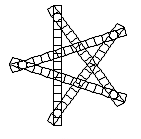Part Two
Meet the Turtle
You’ve already seen the turtle - quietly sitting in the center of the Graphics window - patiently waiting for you to tell it what to do. Well, the waiting is over! You’re about to enter the fascinating world of turtle graphics - a special way of drawing interesting, exciting and colorful graphics on your computer screen by telling a turtle what to do. Not a real turtle, of course. The Logo turtle is a special graphics cursor that can move forward or back, rotate right or left, change color, change size, change shape and even disappear. There’s even more, but let’s do something now.
 Type
Type FORWARD 100 and watch what happens. The
turtle moved in the direction that its head was pointing; the line it
drew is 100 turtle steps long (that’s how turtles measure
distance).
 Now, type
Now, type
RIGHT 90 and you’ll see the turtle has rotated like it’s peeking
around a corner. Turns are measured in degrees, but they’re not called
turtle degrees because that’s how turns are measured by just about
everything, from boats and planes to spaceships.
 If you type these two instructions again and again
and again, you’ll get pretty tired of typing! Here’s a shortcut: type
If you type these two instructions again and again
and again, you’ll get pretty tired of typing! Here’s a shortcut: type
FD 100 RT 90 all on the same line before you press Enter. FD is
short for FORWARD and RT is short for
RIGHT. Next, just press the up-arrow key to
move the cursor onto that line and then press Enter. What could be
easier? You’ll see.
Repeat
There is a very simple way to repeat instructions without typing the
same thing over and over again. It’s the REPEAT command but before you
can use it, you need to learn a little bit about a special type of Logo
data called a list. A list starts with ‘[’ and ends with ‘]’. In
between the brackets is where you put the instructions you want
repeated. Lists are used a lot in Logo but that’s enough to know for
now.
 The REPEAT command needs
a number and a list. The number tells it how many times to repeat and
the list tells it what to repeat. So, to repeat the earlier drawing,
type
The REPEAT command needs
a number and a list. The number tells it how many times to repeat and
the list tells it what to repeat. So, to repeat the earlier drawing,
type REPEAT 4 [FD 100 RT 90]. That’s a lot easier than typing the
instructions four times.
 Don’t forget about the up-arrow key - it’s still
worth using if you make a mistake or if you just want to change a
previous line of instructions. Let’s say you want to change the
Don’t forget about the up-arrow key - it’s still
worth using if you make a mistake or if you just want to change a
previous line of instructions. Let’s say you want to change the REPEAT
we just used so that the turtle does the opposite of what it did last
time. The opposite of FD is BK (short for
BACK) and the opposite of RT is ` LT `
(short for LEFT). See what happens when you
change both instructions to their opposite and then change just one at a
time. Is this a pane? It should be. Try this next: REPEAT 3 [PRINT
“HA].
If your Graphics window is getting a little messy, just type CS to
clean it up and start drawing again. (CS is short for
CLEARSCREEN.) You can clean up the
Listener window by typing CT (short for
CLEARTEXT).
More About the Turtle
There are many Logo commands for the turtle. You can’t learn them all at once but it makes sense to learn them in pairs or groups. Commands that are opposites are easy to learn at the same time. You already know the FORWARD and BACK opposites and the RIGHT and LEFT opposites. Here are some others you can try out:
PENUP or PU - the turtle won’t draw lines
now
PENDOWN or PD - the
turtle will draw lines again
Where’s the pen? It’s right in the middle of the underside of the turtle. If the pen didn’t go up and down, you’d have a hard time making your drawings look nice. Try it with a pencil and some paper and you’ll see what I mean. Does your pencil have an eraser? The turtle’s pen does.
PENERASE or PE - draws in the
background color
Erasing in the Graphics window is not exactly the same as erasing pencil
lines from paper but the effect is the same - what was there is now
gone. To see this happen quickly, try FD 100 PE BK 100 but don’t
forget to put the pen back down when you’re done! Here’s one more pen
trick.
PENREVERSE or PX - inverts the
colors under the pen
This special pen flips colors when it passes over them. In computer speak, the color’s bits are inverted; black becomes white, red becomes yellow, and more. Try to create a drawing, set the turtle’s pen width to, say 10, and draw over your drawing to see interesting color effects!
If the turtle is moving too quickly to follow, type
SLOWTURTLE to slow it down. Type
SETSPEED 1 to restore normal speed.
The Turtle Continued
 When you finish a drawing, do you leave your pencil
in it?
When you finish a drawing, do you leave your pencil
in it?
HIDETURTLE
or HT - the turtle disappears
SHOWTURTLE or ST - the turtle
reappears
Hiding the turtle makes drawing faster
and gets the turtle out of the way. Showing the turtle helps you see
which way it’s heading and where it is. If your turtle gets lost, type
HOME to quickly get the turtle back to the
center of the Graphics window. If you still don’t see it, type
ST.
 When the point of your
pencil gets dull, the lines get wider. The turtle’s pen never gets dull
but you can change its width from 1 to 99. Width 1 is the default. You
may not even see the turtle with a very wide pen!
When the point of your
pencil gets dull, the lines get wider. The turtle’s pen never gets dull
but you can change its width from 1 to 99. Width 1 is the default. You
may not even see the turtle with a very wide pen!
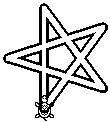 SETWIDTH
or
SETWIDTH
or SETW - changes the pen width (1-99)
With all
the commands you know so far, you can make some interesting special
effects. The star illustration looks very complicated to
create. In fact, the star was drawn with SETW 10 and then erased with
SETW 4.
PD SETW 10 REPEAT 5 [FD 100 RT 144]
PE SETW 4 REPEAT 5 [FD 100 RT 144]
See what you can do. Just play around.
Add Some Color
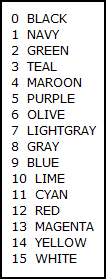 Coloring with the turtle is simple and fun!
You can choose from 16 colors for now. Let’s keep it simple.
Coloring with the turtle is simple and fun!
You can choose from 16 colors for now. Let’s keep it simple.
SETPC - sets the pen color
(0-137)
SETPC needs a
number from 0 to 137. Not only does the pen color change, but the turtle
color changes too, so you can tell which color it will use to draw. The
table of color numbers is shown at the right. Try any color you want.
Pick your favorite.
What about
SETPC 15? Try it. When Logo starts up, the
Graphics screen is white. If you draw with the same color as the
background, it’s like not drawing at all. What if you want to draw in
white?
SETBG - sets the
background color (0-137)
SETBG needs a number from 0 to 137 just like
SETPC. If you set the background color to
the same color as the turtle, the turtle will disappear but you can’t
get it back with ST - you have to make sure the background and the
turtle colors are not the same.
Do you want a green
square? Or, a blue star? Just change the pen color and then use the
up-arrow key to move the cursor back to a previous command line and
press Enter.
Can you make a red diamond? A diamond
is really just a square that’s turned sideways a little.
Teaching Logo Something New
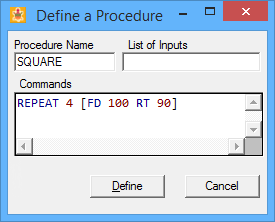 Wouldn’t it be great if you could just type
Wouldn’t it be great if you could just type SQUARE
instead of REPEAT 4 [FD 100 RT 90]? Go ahead and try it but expect an
error message because Logo doesn’t know what SQUARE means. Yet. With
your help as the teacher, Logo can learn new commands! Then, you can
use them just like the built-in commands to save time, typing and typos.
To teach Logo how to square, type TO SQUARE and you’ll see a special
window - think of it as your chalkboard where you’ll write today’s
lesson. May I have your attention, please? Read carefully.
There are three text boxes in the ”Define a Procedure“
window but we only need two of them for now. The ”Procedure Name“ text
box is already filled in and the cursor is in the ”Commands“ text box.
This is where you type the instructions that make a square, just like
you did in the Listener window. Go ahead and type REPEAT 4 [FD 100
RT 90] and then press Enter. Nothing happens.
Instructions you type in the ”Commands“ text box are remembered for
later - not run immediately like they are in the Listener window. Click
the Define button and you’ve just taught your first lesson! You deserve
a raise!
Now, type SQUARE.
More Teaching Fun
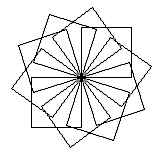 A square is four lines and four turns. But,
what is four
A square is four lines and four turns. But,
what is four SQUARE and four turns? Type REPEAT 4 [SQUARE RT 90] and
see what a square of squares looks like. Change the numbers for
REPEAT and RIGHT
to see what other interesting things you get. How about a pinwheel? How
many squares are in that?
Of course, all of your
squares are 100 turtle steps on a side because that’s how you defined
it. How can you change it? If you type TO SQUARE again, you will see
the procedure on the chalkboard just as you left it. You could change
the FD 100 to FD 50 but then, what if you wanted bigger squares
again later? You’d have to change it back to 100 again. This would get
old in a hurry. Just remember, you’re a teacher!
Why not teach Logo how to make a smaller square? Call it BOX. Just type
TO BOX, press Enter, type REPEAT 4 [FD 50 RT 90], click on the
Define button and there you have it! Now you can draw a big square with
SQUARE and a small square with BOX.
Try defining a procedure to draw a triangle - it’s just three lines and three turns. What about the star? Once you have your new commands defined, see what you can make. Here are some suggestions.

Your Input Matters
 If you want to draw squares of a zillion different
sizes, do you need to define a zillion different procedures with a
zillion different names? That would be silly. The only difference
between
If you want to draw squares of a zillion different
sizes, do you need to define a zillion different procedures with a
zillion different names? That would be silly. The only difference
between SQUARE and BOX is the number after the FD command but how
can you replace that number with any number you want, any time you want,
without changing it over and over again in the ”Define a Procedure“
window? The answer is simple - use an input to your SQUARE procedure
so you can just type SQUARE 100 or SQUARE 50 or use any number as
the actual input.
What’s an actual input?
An actual input is the input you give to a command or
procedure when you actually run it, like the number 100 in FD 100.
An actual input is also called an actual parameter or actual
argument.
What other input is there?
A
formal input is used in the definition of a procedure. It is a
special container with a name chosen by you. A formal input is also
called a formal parameter or formal argument. It is also called a
variable because its contents can change or vary.
You will find that just the word input is often used for both
types of input. Don’t let that confuse you. It’s just easier to say
input.
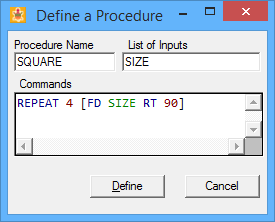 Type
Type TO SQUARE
to bring up the chalkboard again. Click in the ”List of Inputs“ text
box. Since we are going to draw squares of any size we want, let’s use
the name SIZE for our input to SQUARE. Type SIZE and then press
Tab to move the cursor into the ”Commands“ text box. Replace the 100
input to FD with SIZE. When you run SQUARE later on, SIZE will
be automatically replaced with the actual input you give to SQUARE.
Click the Define button to save your new SQUARE.
Now, you can draw squares of any size you want with just the SQUARE
command in the same way you draw lines of any length with the FD
command. Just give SQUARE an input. An actual input, that is. Add an
input to other procedures in the same way. It’s simple, now.
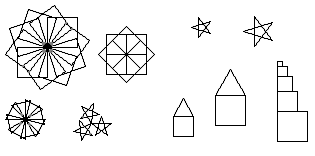 Terrapin Logo allows for ‘Relaxed
syntax’, which does not require the colon in front of names. If you turn
off this option, you will need to use
Terrapin Logo allows for ‘Relaxed
syntax’, which does not require the colon in front of names. If you turn
off this option, you will need to use :SIZE instead of SIZE in your
procedure.
Need More Input?
 Your procedures can have more than one input,
just like the REPEAT command. Suppose you
want to draw a stack of boxes. How would you do that? Of course, you
would use the
Your procedures can have more than one input,
just like the REPEAT command. Suppose you
want to draw a stack of boxes. How would you do that? Of course, you
would use the SQUARE procedure to draw the box. But then what? How
about moving the turtle to the top of the box it just drew? Then, it
would be ready to draw the next box. Now how many boxes do you want in
your stack? How about a short stack of 3 big boxes? Try REPEAT 3
[SQUARE 40 FD 40].
 If you change the 3 to 7, you get a tall stack. If
you change the 40’s to 12’s, you get smaller boxes. You can make stacks
of boxes with one procedure called
If you change the 3 to 7, you get a tall stack. If
you change the 40’s to 12’s, you get smaller boxes. You can make stacks
of boxes with one procedure called STACK and give it two inputs - one
for how many boxes and another for how big to make them. Let’s name them
HOWMANY and HOWBIG.
 Type
Type
TO STACK to bring up the chalkboard. Click in the ”List of Inputs“
and type the names for the two inputs. Press Tab to move into the
”Commands“ window and type in the instruction to draw a stack of any
number of boxes of any size.
- Where will you put
HOWMANY?
- Where will you put HOWBIG?
- How
about a star made from stacks?
REPEAT 5 [STACK 15 7 RT 144]
